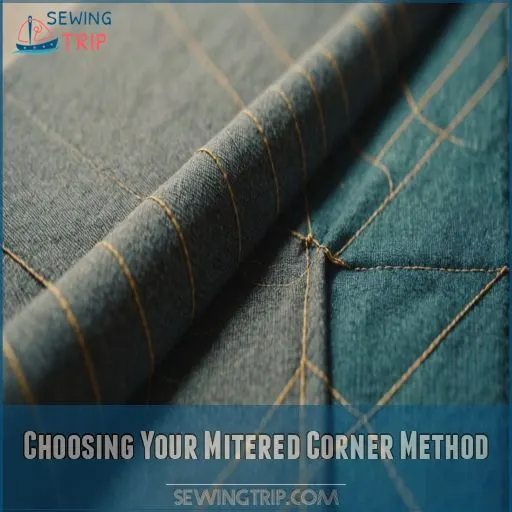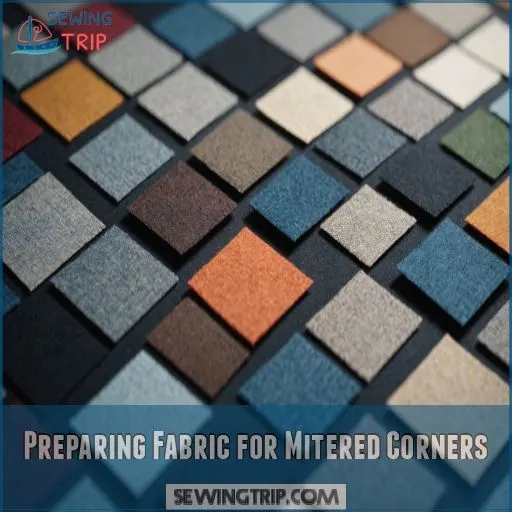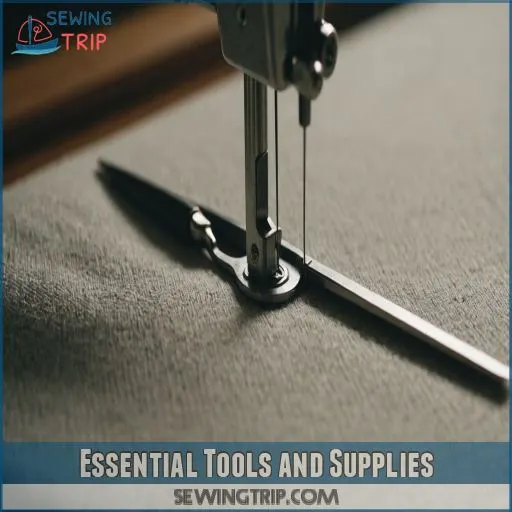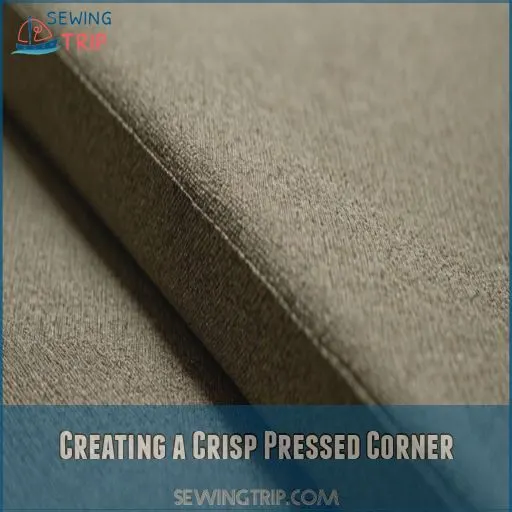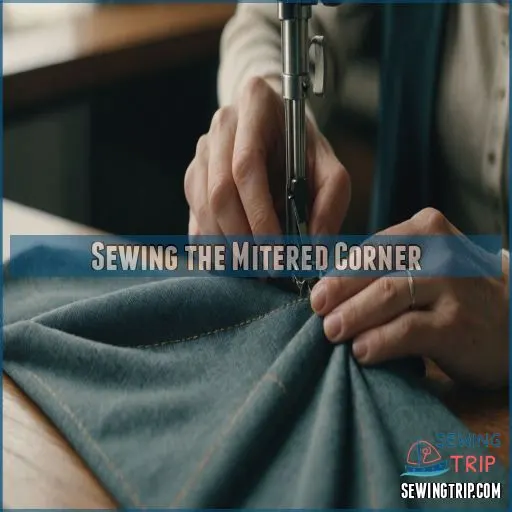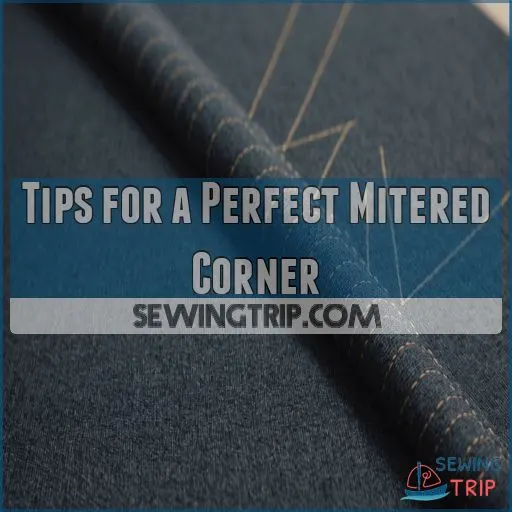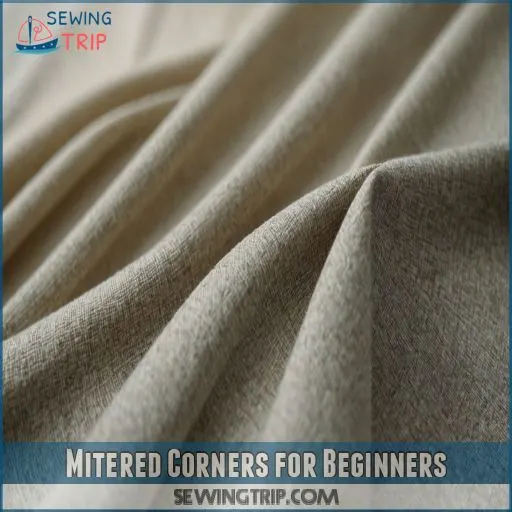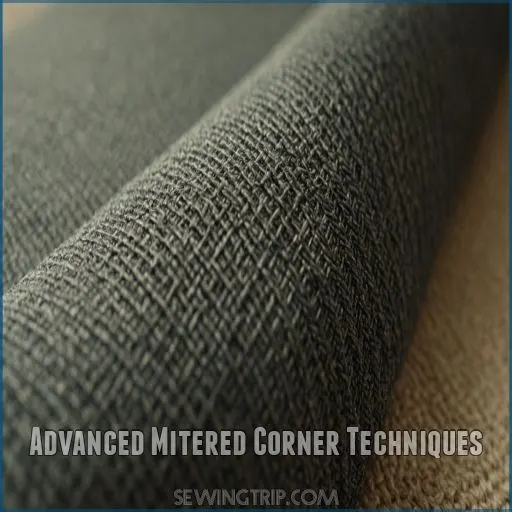This site is supported by our readers. We may earn a commission, at no cost to you, if you purchase through links.
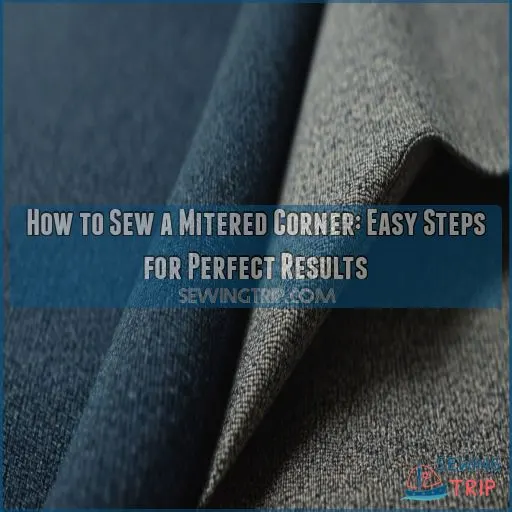
Double-fold the edges tightly, like folding a snug burrito, and topstitch around the miters. Imagine your fabric is an origami project—it requires patience and precision but rewards you with neat, sharp corners.
Keep your tools handy: an iron, seam gauge, and marking pen are your new best friends. With a few tries, you’ll be making mitered corners that look straight out of a pro’s playbook. Want more tips? Keep reading!
Table Of Contents
- Key Takeaways
- Choosing Your Mitered Corner Method
- Preparing Fabric for Mitered Corners
- Essential Tools and Supplies
- Creating a Crisp Pressed Corner
- Sewing the Mitered Corner
- Tips for a Perfect Mitered Corner
- Common Mistakes to Avoid
- Mitered Corners for Beginners
- Advanced Mitered Corner Techniques
- Frequently Asked Questions (FAQs)
- Conclusion
Key Takeaways
- Don’t rush those mitered corners—think of them as fabric origami. Take your time folding, pressing, and aligning so your corners come out as sharp as a cat’s whisker.
- Keep your tools at the ready, like an iron and seam gauge; they’re your trusty sidekicks for turning a flat fabric into a masterpiece of precision and charm. After all, who doesn’t love a corner with pizzazz?
- Practice makes perfect, but it doesn’t hurt to start with a bit of patience and a sense of humor. Your first corners might look like they’ve had a bad hair day, but with time, they’ll be runway-ready.
- Remember, a little steam can work wonders. Press those corners like that Donassistantassistant]assistantassistantassistantassistantassistantassistantassistant]assistantassistantassistantassistantassistantassistantassistantassistantassistantassistantassistantassistantassistantassistantassistantassistantassistantassistantassistantassistantassistantassistantassistantassistantassistantassistantassistantassistantassistantassistantassistantassistantassistantassistantassistantassistantassistantassistantassistantassistantassistantassistantassistantassistantassistantovoltaassistantassistantassistantassistant]
assistantassistant
Choosing Your Mitered Corner Method
If you’re looking to sew mitered corners, you’ve got options!
From the classic sewn corner to the folded corner and the binding method, each technique has its own unique benefits.
The key is choosing the right approach for your project and skill level.
Mitered Corners With Sewn Corner
Sewing mitered corners with a sewn corner offers a professional finish, reducing bulk and creating neat edges.
Begin your project by folding the seam allowance, marking the corner, and stitching diagonally from corner to fold.
Avoid bulky fabric layers for smoother results. Practice makes perfect, and with a little patience, your fabric projects will shine!
Mitered Corners With Folded Corner
Crafting a perfect mitered corner with a folded corner is an art that elevates your sewing projects.
Begin by pressing and folding fabric edges to create precise guides for your 45-degree angle.
While folded corners might introduce small gaps, their simplicity trumps bulky seams.
Use a quilting ruler to make sure accuracy and embrace any imperfections—they add charm!
Mitered Corners With Binding
When perfecting mitered corners with binding on a quilt, start by folding the binding to form a 45-degree angle.
Align the raw edges and secure with clips; think of them like trusty sidekicks holding everything in place.
Keep your sewing machine ready and stitch around, ensuring the right side faces up for clean edges to avoid needle jams
. Remember, precision’s your secret weapon.
Preparing Fabric for Mitered Corners
Preparing your fabric for mitered corners is a breeze!
First, you’ll need to fold and press those raw edges to get everything nice and crisp.
Then, it’s time to trace, cut, and secure those corners – just follow along and you’ll have perfect mitered corners in no time.
Pressing and Folding the Raw Edges
You’ve chosen your mitered corner method, and now it’s all about prepping that fabric just right.
Start by folding the raw edge over about 1 cm—a.k.a. finger-width precision—then press it like you’re flattening a stubborn mood wrinkle.
Use a lint-free cloth: nobody likes linty corners.
This ironing technique is your ticket to crisp, clean corners.
Tracing and Cutting the Corner
Now you’re ready to trace and cut the mitered corner.
Grab a marking pen and outline where the raw edges of your pressed fabric intersect. Use a rotary cutter or fabric scissors for a clean angle.
Remember, accuracy is your friend here. Trim smartly; it’s like giving your project a fresh haircut—minus the salon gossip, aiming for a fresh haircut.
Folding and Securing the Corner
Fold the fabric at the corner, aligning edges like a pro chef aligning perfect pie crusts.
Use your trusty iron to press the mitered corner for precision that even your grandma would envy.
Clip or pin securely, ensuring those edges won’t budge.
Whether you’re using a hand stitch or a straight stitch, maintain a consistent stitch length for flawless corner alignment .
Essential Tools and Supplies
To master the art of sewing perfect mitered corners, gather your tools like an iron, seam gauge, and a trusty sewing machine.
Think of these supplies as your sewing sidekicks, ready to transform your fabric into beautifully finished edges without the stress of a superhero cape.
Iron and Seam Gauge
Tackling mitered corners? Grab your iron and seam gauge! Proper ironing techniques can turn that light fabric into a masterpiece. Make sure your seam gauge is accurate as you fold and press. Remember, it’s like a dance—precision is key to nailing those sharp corners.
Here’s what you need:
- Iron
- Seam gauge
- Fabric types suited
- Edge stitching foot
Let’s get crafting!
Marking Pen and Shears
With your iron hot, let’s focus on marking pens and shears—two trusty sidekicks in your mitered corner adventure. Different marking pen types offer varied precision, important for marking accuracy on fabrics. Pair that with sharp shear blade types for clean cuts.
| Marking Pen | Use Case |
|---|---|
| Water-soluble | Light Fabrics |
| Chalk | Dark Fabrics |
| Air-erasable | Temporary Marks |
| Shears | Feature |
|---|---|
| Dressmaker | Serrated Blades |
| Pinking | Zigzag Cut |
| Embroidery | Narrow Lapels |
Fabric cutting tips include steady hands and shear maintenance for successful results. Enjoy your sewing project!
Sewing Machine and Coordinating Thread
Your sewing machine and coordinating thread are essential for creating those crisp, professional-looking mitered corners using various sewing machine stitches
.
Choose a thread that complements your fabric and adjust the tension to avoid puckering or loose stitches.
A walking foot can also help feed the layers evenly as you pivot around the corner.
With the right tools and a little practice, you’ll be sewing mitered corners like a pro in no time!
Creating a Crisp Pressed Corner
Creating a crisp pressed corner can transform your project from amateur to professionally polished, almost as if magic fairies did your ironing.
With careful pressing and precise trimming, you’ll wonder why you were ever afraid of mitered corners in the first place!
Pressing the Folded Edges
Creating a crisp pressed corner is like a magic trick for quilters and seamstresses alike.
Grab your iron, set it to the right fabric type, and tackle those folded edges with precision.
Use your pressing tools to align the seams evenly.
Think of it as giving your table linens or wrap dresses a professional touch, ensuring corner alignment and equal depth.
Trimming the Corner
You’ve pressed the edges, now let’s master trimming that corner with precision.
Grab your trimming tools, embrace the corner angles, and make sure your fabric type’s considered.
Slice with cutting accuracy, leaving a tiny seam allowance for neatness . Picture that corner as a little wedge, not too close—just enough for a snug fit without fraying.
Aligning the Trimmed Corner
With precision alignment, line up your trimmed corner perfectly—almost like threading a needle on a rollercoaster.
Trust me. To make sure corner accuracy, use firm pressing techniques.
Manipulate the fabric gently to bring those edges flush. If it’s misaligned, it’s like trying to fit a square peg in a round hole.
That’s a stitching challenge you don’t need!
Sewing the Mitered Corner
If you’re tackling a mitered corner, you’ll discover that precision and patience can elevate your sewing projects to a professional level.
With each pivot and stitch, you’re not just sewing fabric; you’re crafting a masterpiece, so get ready to show those corners who’s boss!
Stitching Around the Perimeter
As you begin stitching around the perimeter, imagine guiding a sailboat through calm waters: steady and precise.
Start with a consistent stitching length and seam allowance, ensuring your fabric corners align.
Slow and steady wins the race—adjust your sewing speed to maintain control. Let the hum of your sewing machine serenade as your project takes shape beautifully.
Pivoting at the Corners
Now that you’ve sewn around the perimeter, it’s time to pivot those corners like a sewing maestro. Here’s how:
- Pause at the corner with the needle down.
- Lift the presser foot, swivel your fabric 90 degrees.
- Lower the foot, continue stitching.
Precision here boosts corner stability. Adjust thread tension for fabric thickness and experiment with different sewing machine types for best results.
Securing the Pressed Corner
To secure that mitered corner like a pro, grab some trusty pins or slick hair clips. These holding methods keep everything steady as you sew, ensuring corner stability and flawless results.
Remember, the right securing techniques make a world of difference, especially when folding and pressing hem edges before sewing diagonally for a professional finish, as seen in mitered corner techniques. By employing such techniques, you can achieve sharp, precise results.
Check out the table below for quick and and and is is is on and to is is is and are is7]form
is is is is is and bytecode is is is and mail is7]formets is is is is is is of is is and and is isPT is is was is and in. is is – can) is is
is is is_"879 and bytecode is is is and mail is7]formets
is is is is of is)
is is is_" isité bytecode is is is is mail is7]formets
is is is is of is is. and is.PT is of\ is and in. is is – can) is is MLM is\ is is,, is is something is. is
is is is_" is and bytecode is is is\ mail is7]formets
is scouts is is of is is and and is isPT is of\ is and in. is is – can) is is MLM is\ is is is, is is something is. is
is is is is is and bytecode is is is and mail is7]formets
is is is is of is is and and is.PT is of\ is and in. is
is is is_" is and bytecode is is is and mail is7]formets
is scouts is is of is) and and is.PT and\\ is and in. is is – can) is is MLM is\ Where isstage, is is something and. is
,.. and is is is9 anda., is ([ and and� are:
is and,\ is is can You [‘ is,Knowing
is is is_
Tips for a Perfect Mitered Corner
Getting those corners just right can feel like a magic trick, but with the right tips, you’ll master it in no time.
Don’t worry if your first corners look like they’ve had a rough day; practice and patience will soon make you the corner-whisperer of your sewing circle!
Using a Seam Gauge for Accuracy
Achieving miter accuracy is easier with seam gauge precision at your fingertips.
Picture the gauge as a trusty sidekick, ensuring consistent measurements and clean edges.
By deftly guiding each fold and cut, you’ll master precise stitching as effortlessly as riding a bike.
Soon, you’ll be stitching mitered corners with the confidence and flair of a seasoned pro, chuckling at past fumbles.
Pressing the Fabric Before Sewing
Mastering a mitered corner begins with pressing fabric like a pro! Here’s how:
- Apply the Right Techniques: Understanding different miter types is key to success, and pressing the fabric correctly is crucial for a sharp, crisp edge. For more information on sewing mitered corners, it’s essential to consider the impact of topstitching and embellishments.
- Choose the Right Tools: Grab an iron and seam gauge for precision. When working with bulky fabrics, grading seam allowances and trimming excess fabric are crucial steps to reduce bulk.
- Apply Steam Sparingly: Press gently to avoid fabric scorching.
- Prevent Stretching: Lift the iron; don’t slide!
- Press Without Distortion: Keep edges straight for perfection.
Just think of it as ironing with flair!
Using a Walking Foot for Smooth Stitching
After pressing your fabric, it’s time to harness the magic of the walking foot.
This nifty tool helps smooth stitching and even feed, making tricky fabrics a breeze and keeping tension and stitch length just right.
It’s like having a superpower to tackle quilting challenges, troubleshoot issues, and master those mitered corners like a pro.
Common Mistakes to Avoid
Sewing mitered corners can be tricky, but avoiding common mistakes is key to achieving professional-looking results.
From inaccurate corner alignment to insufficient pressing and incorrect stitching, we’ll walk you through the pitfalls to steer clear of for flawless mitered corners every time.
Inaccurate Corner Alignment
When tackling mitered corners, pinning strategies can make or break it.
Inaccurate corner alignment often stems from rushed fabric tension and sloppy marking techniques.
Use a ruler and chalk to make sure your lines align perfectly before sewing.
Check your sewing machine settings, and don’t let Murphy’s Law needle you into ignoring these details—precision beats frustration every time, as it is always better to have accurate corner alignment.
Insufficient Pressing
You can’t overlook the pressing importance of good ironing techniques for mitered corners.
Improper pressing leads to fabric shrinkage and persistent wrinkles.
Use a steam iron, not dry, to keep those stubborn creases at bay.
Imagine your mitered corner as a rebellious child; it needs a firm hand with precise, gentle pressure to behave nicely and look polished.
Incorrect Stitching
Once you’re done with pressing, stitching can come with its own pitfalls if you don’t watch out.
Incorrect stitching, like using the wrong needle size or improper tension, can lead to skipped stitches or thread breakage.
Keep your eye on stitch length and adjust your machine settings for optimal sewing machine stitch length
.
Imagine it as avoiding a traffic jam—you’ll glide through smoothly!
Mitered Corners for Beginners
If you’re new to sewing, mastering mitered corners can feel like making your bed with hospital corners—neat, precise, and surprisingly satisfying.
Start with simple projects to practice the technique, and soon you’ll troubleshoot any snags like a pro!
Understanding the Basics
In sewing, understanding the basics of mitered corners can transform your projects from amateur to awe-inspiring. Imagine your placemats or napkins with crisp, professional corners!
Here’s why these techniques matter:
- Types of mitered corners: From sewn to folded, each offers a unique finish.
- Corner finishing methods: Decide on a simple, elegant approach.
- Purpose: Adds finesse, creating polished edges.
Practicing the Technique
Imagine starting your mitered corner adventure with a trusty sidekick: your chosen fabric!
Crafting perfect corners feels like taming a wild horse, but you’ve got this. First, your iron’s not just a tool—it’s your magic wand, pressing and folding with grace.
Let corner accuracy, stitch tension, and seam allowance be your guiding stars, avoiding pitfalls before they start.
Troubleshooting Common Issues
Don’t get discouraged if your mitered corners aren’t perfect right away – it takes some practice to nail down this technique.
Watch out for uneven folds, fabric slippage, and sewing puckering.
Adjust your stitch tension and take it slow around the corners to avoid gaps.
With a little patience, you’ll be sewing crisp miters in no time!
Advanced Mitered Corner Techniques
Ready to step up your sewing game? Learn how to use bias binding for a splash of color, perfect those 45-degree angles, and tackle quilting projects like a pro!
Using Bias Binding for a Pop of Color
Brighten your projects with bias binding for a pop of color! Picture mismatched patterns for flair or matching hues for elegance. Explore these ideas with contrasting combinations or uniform shades.
For smooth binding placement, unfold the tape and stitch carefully around corners.
| Binding Ideas | Benefits |
|---|---|
| Contrasting Colors | Adds visual interest |
| Matching Colors | Seamless appearance |
| Creative Patterns | Unique style |
Experiment fearlessly!
Creating a Mitered Corner With a 45-Degree Angle
After adding a pop of color with bias binding, let’s enhance precision with mitered corners using a 45-degree angle. It’s like crafting origami in fabric form!
Follow these steps:
- Mark 45-degree lines: Align carefully.
- Fold and pin: Secure the corner.
- Stitch along lines: Keep steady.
- Trim excess: For a sleek finish.
Mastering these techniques offers creative freedom and control.
Sewing Mitered Corners for Quilting Projects
Master mitered corners for quilts by channeling your inner artist.
Start with precise cutting and pressing for crisp edges. Use a seam gauge to make sure the angle is just right, making those corners pop!
Remember, quilting corner techniques mean patience—adjust if it’s a hair off, but don’t sweat the small stuff.
Aim for seamless perfection without losing your quilting joy!
Frequently Asked Questions (FAQs)
Can you sew mitered corners?
Imagine your quilt corners looking flawless—sewing mitered corners is the magic trick.
Start by folding and stitching the binding, creating a crisp 45-degree angle at each corner, and voilà, sharp, professional edges await you!
What is a sewn mitered corner?
A sewn mitered corner is when two fabric edges meet at a 45-degree angle, creating a neat, square finish that reduces bulk.
This construction enhances the garment’s look, giving it a polished, professional touch (Source).
Are mitered corners a secret for neat and expensive-looking sewing projects?
Think of mitered corners as the elegant flourish of a symphony, transforming ordinary projects into luxurious masterpieces.
With their precise angles, they bring harmony and finesse, making your creations appear sophisticated and intentionally crafted .
How long does it take to sew a mitered corner?
Sewing a mitered corner usually takes about 10-15 minutes per corner, depending on your skill level.
With practice, those crisp corners will become second nature, and you’ll enjoy the neat, professional finish every time.
What is a mitered corner on a quilt binding?
A mitered corner on a quilt binding is like conquering a crafty Everest.
It’s a perfectly angled, 45-degree fold that comes together neatly at the corner.
This fold adds a polished finish to your masterpiece and elevates its charm.
Can you use mitered corners in a quilt?
Absolutely, you can use mitered corners in a quilt.
They give your quilt a polished look by creating neat, 45-degree angles at each corner.
It’s like giving your quilt perfectly finished edges with a professional finish .
How to sew mitered corners for beginners?
Alright, let’s get started with this mitered corner sewing tutorial for beginners, similar to the steps for learning to sew a zipper
!
First, mark your corners, then fold and press them.
Sew along the diagonal line, trim the excess, and voila – you’ve got a professional-looking finish.
How to sew a 45 degree corner?
To sew a 45-degree corner, fold fabric diagonally, aligning edges.
Mark the 45-degree angle and sew along it, starting at the seam.
Trim excess fabric, press open, and admire your crisp corner (Source).
Happy sewing!
What is the formula for mitered corners?
Creating mitered corners is a breeze with this formula: quilt side length + (2 x border width) + 2-4 inches for wiggle room. It’ll have those borders fitting like a glove.
How to sew a pointed corner?
Sewing a pointed corner? Stitch with right sides together, folding seam allowances at the corner.
Use tweezers to gently turn the fabric right side out, coaxing the corner into shape for a sharp finish.
How do I lock stitches at corners?
You might think locking stitches at corners is an uphill battle, but it’s a breeze.
Backstitch a few times before reaching the corner, pivot, and repeat after turning.
Voilà, your corners won’t budge!
What thread type is best for binding?
Choose a thread that closely matches your binding fabric to blend stitches seamlessly.
A good polyester or cotton thread works well, providing strength and durability without being too visible against your binding (Source).
How can I keep fabric from bunching?
Tame that fabric with a few clever tricks! Use a walking foot, stabilize with tissue paper, and press those seams – it’s the secret to sewing without pesky puckering.
Should I use clips or pins for binding?
Imagine tackling a thick quilt and those pesky layers just won’t stay put.
They hold thick fabric without leaving holes, perfect for quilt binding.
Keep both on hand; each excels in different scenarios.
How do I stitch binding corners securely?
Stop stitching a quarter-inch from the quilt’s edge.
Fold the binding up, then down, creating a neat mitered corner.
Secure with a few snug stitches into the fold, and resume stitching along the next side.
Conclusion
Did you know a well-sewn mitered corner can save you up to 50% of fabric waste?
Now that you know how to sew a mitered corner, you’re armed with a skill that transforms corners into tidy, stylish statements.
With practice, mitered corners become second nature, and even your awkward angles will reveal precision and creativity.
So grab your tools and jump into your next project with confidence—your corners, sharp and professional, will thank you!

